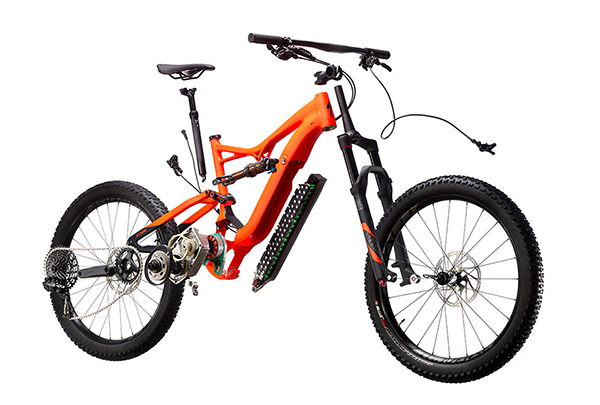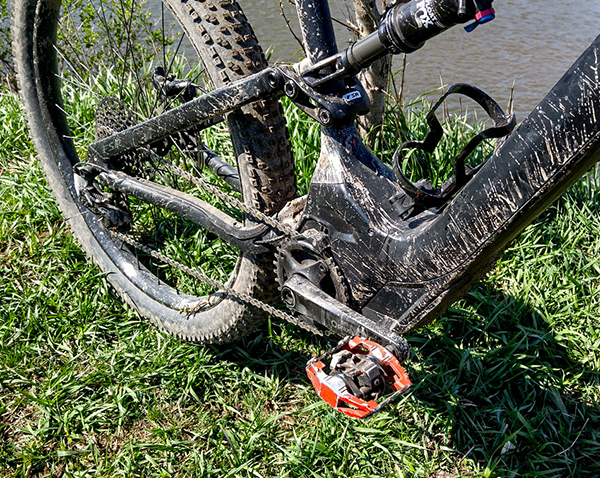June 12/17 16:22 pm - Rob's Review - Specialized Turbo Levo FSR Comp 6Fattie
Posted by Editor on 06/12/17
Motorized bicycles, power assisted, e-bike, pedelec ... whatever you call them, these machines are either the future of cycling or some kind of 'cheat' that is destroying the sport and activity of cycling.
This article began - and is still anchored by - a review of the Specialized Turbo Levo FSR Comp 6Fattie; one of the new breed of eMTBs that is just beginning to make inroads into our market. However, they are coming - Marco Sonderegger, who is the e-bike Product Manager for Specialized, told me in a conversation we had during my research for this story that in countries such as Germany and Switzerland, eMTBs are now outselling the Stumpjumper; Specialized's best-selling mountain bike for many years.

"It started slowly four years ago, but the last two years have just exploded, and we are not selling so much in push bikes. I think North America is just a few years behind."
Both Mike Badyk and I rode the Levo multiple times, with Mike probably putting in 30 hours in the saddle. You can skip directly to Mike's review HERE, because I'm going to talk a bit about what an e-bike is (and isn't), how the e-bike market has changed over the last few years and why you need to manage preconceived views - I know my rides on the Levo had an impact on my feelings about e-bikes.
First, some clarification on the types of bikes that are loosely grouped under the heading 'e-bike'. A Pedelec (sometimes called a power assisted bicycle) requires rider input for the motor to engage and provide assisting power. In other words, there is no throttle so that it can run just on battery power. In all Canadian jurisdictions that is a requirement for a bike to qualify as an e-bike which may use bike lanes, not require licencing, etc. There are also restrictions on the amount of power and the maximum speed which the power assist can attain. Anything with a throttle is, for all intents and purposes, a scooter (and we won't be looking at those).
Power can be supplied to either the front or rear wheel (usually rear), or the motor can be in the bottom bracket (crank). The more sophisticated units seem to be moving towards bottom bracket motors (which is what the Levo uses).
The vast majority of e-bikes currently sold in North America are not sold through traditional bike shops and are not brand names that cycling enthusiasts would likely recognize. A large number of those are actually throttle-controlled and are used primarily for commuting and recreational riding (a large market is retiree use in the southern U.S.).
Edward Benjamin, of eCycleElectric Consultants in the United States (www.eCycleElectric.com), is an e-bike expert who has followed the market for over a decade. He estimates that the U.S. e-bike market was around 240,000 units in 2016, and that that about half of all e-bike imports appear to be minimum priced, but mostly lithium powered, Chinese sourced bikes. He does not have statistics on the Canadian market, but his perception is that the Canadian market is proportionately larger than the U.S. He also believes that eMTBs are starting to take off and could quickly become a significant part of the market, which brings us back to the Levo.
So, now that the long preamble is over, let's actually talk about riding the Specialized Turbo Levo FSR Comp 6Fattie. Mike talks about the spec and geometry in his review (Here), so I'm going to focus on my impressions.

The first thing is that, other than the oversized bottom bracket, it doesn't look much different from a regular full suspension bike. However, the first time you go to lift it, the difference is immediately apparent; roughly six kilograms more than a non-electric bike. This is significant in that it makes the bike much more difficult to lift into or out of a vehicle, up from a basement, etc. However, when you are riding the Levo with power assist it is not an issue at all.
On the very first ride it becomes very apparent that you have to make changes to your riding style. The power is delivered based on your input on the pedals. For example, on technical obstacles if you feather the pedals the motor keeps kicking on and off, which can give you power at unexpected intervals. Instead, you need to plan your pedal strokes. Also, while you might normally grind up a climb, you can get more assistance by spinning.
This sounds very complicated, but really it is like when you first started on a regular mountain bike and were learning to modulate your power for different types of terrain; there's a learning curve. By my third and fourth ride I was starting to get the hang of it and could begin to use the assistance effectively.
One of the biggest issues that I and (I'm assuming other riders) have with e-bikes is the philosophical question of whether you are somehow cheating because you are getting assistance. Marco from Specialized agreed that this is something they came across in Europe in the early days.
"People need to try it out," he says. "It's not about cheating, it's that you can cover more ground and ride more trails in the time you have available. You still have to pedal."
As I used the Levo I started to appreciate his point - I certainly am not as fit or strong as I used to be; a function of age and work requirements. So, this has meant that I have struggled at times to clear sections that require more power than I have, and that I can't ride as many trails in a given session due to time and fitness constraints.
With the Levo, I still push as hard as on my regular bike so I get a good workout, but I can cover more ground. Also, some climbs that I run out of power on I can now clear; meaning I'm riding rather than pushing.
Cheating implies an unfair advantage - which is of course the case in sanctioned racing - but let's be honest: I'm out there to ride for enjoyment and fitness, and if the Levo allows me to do more of both then I consider it a positive.
As Mike says in his review, there are still issues with e-bikes. Weight and range are the primary ones, just as they are for automobiles, and Marco admits that any major changes are going to depend on technological advancements. However, with regard to range anxiety (which Mike talks about in his review), the Specialized Mission Control App (available for Apple, Android, Garmin and anything with ANT+) you can set the system up to meter out power based on your planned length of ride (in time), plus the % of battery life you want left at the end of the ride.
I came into the review of the Specialized Turbo Levo FSR Comp 6Fattie rather skeptical as to the value of eMTBs. I finished it anticipating that I might be looking at one in the not too distant future.
| Return to Canadian Cyclist homepage | Back to Top |





